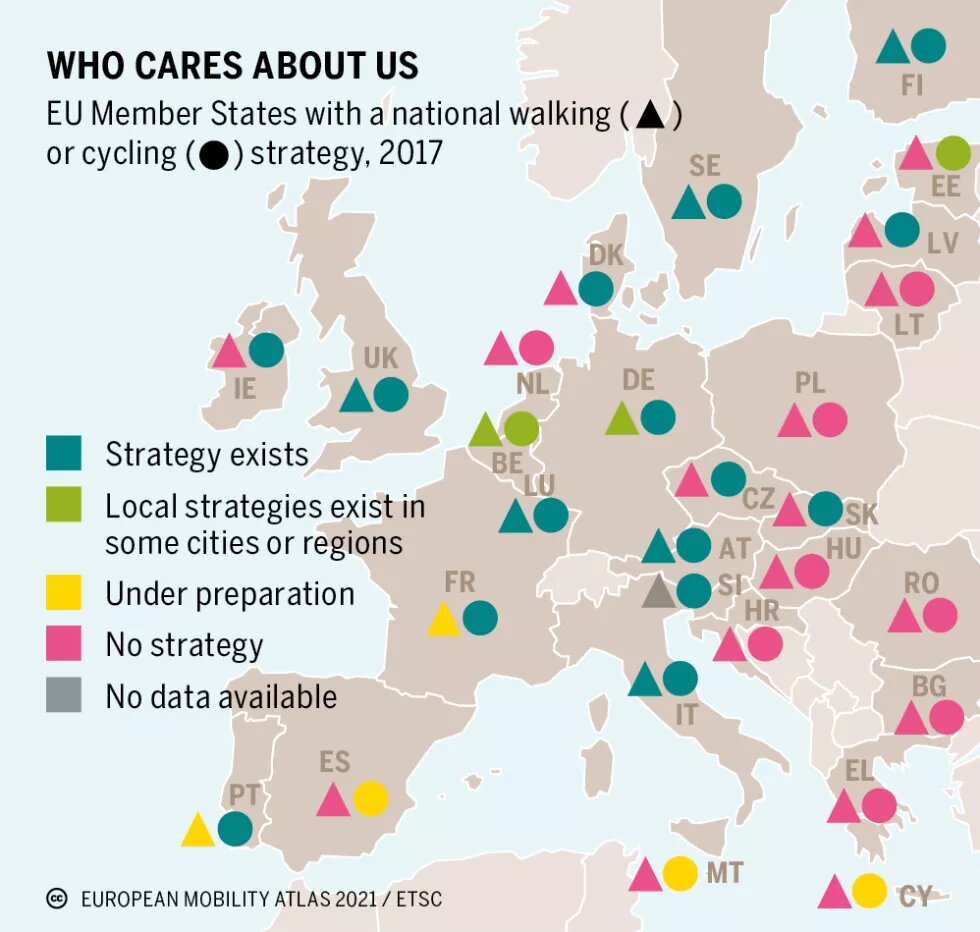
Cyclists and pedestrians run a high risk of being killed in road traffic. At national and EU levels, a variety of initiatives aims to protect them better. However, more is needed to ensure effective pedestrian and cyclist safety.

The European Union (EU) faces a multitude of interconnected demographic, public health and environmental challenges: the climate is changing; road deaths are not falling as fast as one would hope for – although the 'Covid-19 effect' is noticeable due to less traffic; urbanisation is increasing, air pollution is worsening, obesity is rising and the population is ageing.
There is an increasing recognition at local, but also national and EU level, that boosting active mobility, particularly walking and cycling, can play an important role in overcoming many of these challenges. Being the most vulnerable road users, at least 51,300 pedestrians and 19,450 cyclists were killed on EU roads between 2010 and 2018. In 2018 alone, total road deaths was 25,058, including 5,180 pedestrians and 2,160 cyclists. The total in 2019 was 22,800.
Deaths among pedestrians and cyclists accounted for 29 percent of all road deaths across the EU. These groups are also the least likely to harm other road users. There are no silver bullets for improving the safety situation. Several governments have started to put in place strategic planning to improve pedestrian and cyclist safety, including ambitious targets and priority areas for action. A proactive approach, involving all relevant stakeholders in the preparation and execution of the plans, clear deadlines and an appropriate budget for implementation are some of the crucial elements for success. Some governments have developed and are implementing national walking and cycling strategies, but the level of detail and ambition on safety differ.
A number of local authorities in the EU have started working on preparing and implementing Sustainable Urban Mobility Plans (SUMP), but improvements are needed to ensure that these plans are closely linked to road safety priorities, particularly for pedestrians and cyclists.
The EU road safety policy framework 2021-2030 includes a list of key performance indicators (KPI), developed in cooperation with Member States. The KPI on speed, protective equipment and vehicle safety are related to pedestrian and cyclist safety. Tracking the progress for each KPI will help decision-makers to develop well-informed and more targeted policies. Over the last years, the European Parliament, the Committee of the Regions and the European Transport Safety Council and other stakeholders that are working on reducing the numbers of deaths and injuries in transport have called for the European Commission to come forward with a cycling strategy for the EU. An EU-wide safe active mobility strategy, to encourage a coordinated European response to the challenge of making walking and cycling as safe as possible, could also be useful.
Infrastructure can contribute to reducing speeds and separating pedestrians and cyclists from motorised vehicles. This can reduce both pedestrian and cyclist deaths and severe injuries when collisions do occur, or even prevent those collisions from happening.
At the EU level, the revised EU Road Infrastructure Safety Management (RISM) directive mandates, for the first time, to systematically take vulnerable road users, including pedestrians and cyclists, into account in all infrastructure safety management procedures on the roads covered by the directive. Pedestrians and cyclists mostly travel on urban roads.
EU Member States are encouraged to extend the safety management principles of the RISM directive to their urban roads. At speeds of below 30 km/h, cyclists can mix with motor vehicles in relative safety. Traffic calming measures in 30 km/h zones are essential to discourage drivers from exceeding the speed limit. Enforcement on roads limited to 30 km/h also has a contribution to make where engineering measures by themselves are insufficient to bring drivers to safer speeds.
Efforts should also be made to keep cyclists and pedestrians separate, by giving each of them, where possible, enough space so that they do not intrude on each other's space. Increasingly, urban planning must also take into account new personal modes of transport such as e-scooters, particularly how to keep their riders, as well as pedestrians and cyclists sharing space with them, out of harm’s way.
Following an agreement reached in 2019, the revised EU General Safety Regulation and Pedestrian Safety Regulation have been updated with improved passive and active safety requirements for all new vehicles sold in the EU. Many of those new vehicle safety requirements, such as Intelligent Speed Assistance (ISA), Automated Emergency Braking (AEB) with vulnerable road user detection, enlarged head impact protection zones, direct vision requirements and Blind Spot Detection Systems for heavy goods vehicles will contribute to improving pedestrian and cycling safety.
To accelerate the market penetration of safe vehicles, Member States and local authorities can introduce public procurement requirements and urban access regulations to promote safer vehicles. With a comprehensive approach, strategic planning and cooperation between all levels of government as well as with road safety stakeholders, many of the challenges in improving pedestrian and cycling safety can be met.
Sources for data and graphics: European Transport Safety Council, PIN Flash 38, https://bit.ly/3oKCAiX; European Transport Safety Council, PIN Flash 38 Background Tables, https://bit.ly/3kKFaTG

